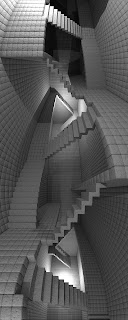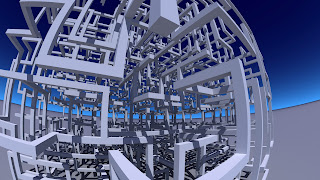Today I'm going to show a set of renders that although they are not totally finished I would like to show.
In order to make the renders we have to do this. It's necessary to model the scenery in such a way so the dimensions fit using whole units (fitting into a grid). So we make sure that all walls, walkways and stairs have similar widths. With any CAD program it's possible to model the scenery looking the original drawing. The objects at this point have box geometry.

Because the rendering of boxes is too dull we have to add some effects. One of those has to emulate the round shape of a stone. In order to achieve that we can use textures or 3D models. In this case I preferred using 3D models to achieve more quality. Accomplishing this is simple. We cubicate the scene with the same resolution of the design grid. Now we have a set of voxels. Each voxel is replaced by a rounded cube mesh shape. The only problem is the amount of data and so the high processing time.

Later we apply a material to the surface. For that is used a composite material. The material is composed by one control map and two data maps. The control material is used to decide the amount of blending between the data materials. It's similar to an alpha blending. For the control map I have used a binary threshold discretized Perlin noise function. In the high part I have assigned one kind of bumpmap and in the lowest part another kind. So, two bumpmaps of controllable independent characteristics are obtained. Now we simply apply a greater scale factor and noise to one to look like holes in stone, while applying a smoother noise to the other. With only one bumpmap would have achieved a smoothed and polished stone effect with some holes. We don't want it.

Finally to render it's used a cylindrical camera to emulate the curved effect of "The House of Stairs". With a little wise we can place the camera more or less the same position where Escher sat it.
The target is the representation in 3D of the picture "House Of Stairs" of M.C.Escher. I focused the representation of walls and stairs. The strange animals and the doors are missing.
The results are these, in black and white and in color:
The results are these, in black and white and in color:
 |  |
In order to make the renders we have to do this. It's necessary to model the scenery in such a way so the dimensions fit using whole units (fitting into a grid). So we make sure that all walls, walkways and stairs have similar widths. With any CAD program it's possible to model the scenery looking the original drawing. The objects at this point have box geometry.

Because the rendering of boxes is too dull we have to add some effects. One of those has to emulate the round shape of a stone. In order to achieve that we can use textures or 3D models. In this case I preferred using 3D models to achieve more quality. Accomplishing this is simple. We cubicate the scene with the same resolution of the design grid. Now we have a set of voxels. Each voxel is replaced by a rounded cube mesh shape. The only problem is the amount of data and so the high processing time.

Later we apply a material to the surface. For that is used a composite material. The material is composed by one control map and two data maps. The control material is used to decide the amount of blending between the data materials. It's similar to an alpha blending. For the control map I have used a binary threshold discretized Perlin noise function. In the high part I have assigned one kind of bumpmap and in the lowest part another kind. So, two bumpmaps of controllable independent characteristics are obtained. Now we simply apply a greater scale factor and noise to one to look like holes in stone, while applying a smoother noise to the other. With only one bumpmap would have achieved a smoothed and polished stone effect with some holes. We don't want it.

Finally to render it's used a cylindrical camera to emulate the curved effect of "The House of Stairs". With a little wise we can place the camera more or less the same position where Escher sat it.




















